Published: October 04, 2022
A “Vū” of the Future
By Jessica Blatt Press
Photography by Marc Vaughn
Most undergraduates who pursue film and media are familiar with the limitations of student set design: the reliance on repurposed backdrops, scant resources for creating intricate scenes, minimal access to locales beyond what’s readily available in the neighborhood.
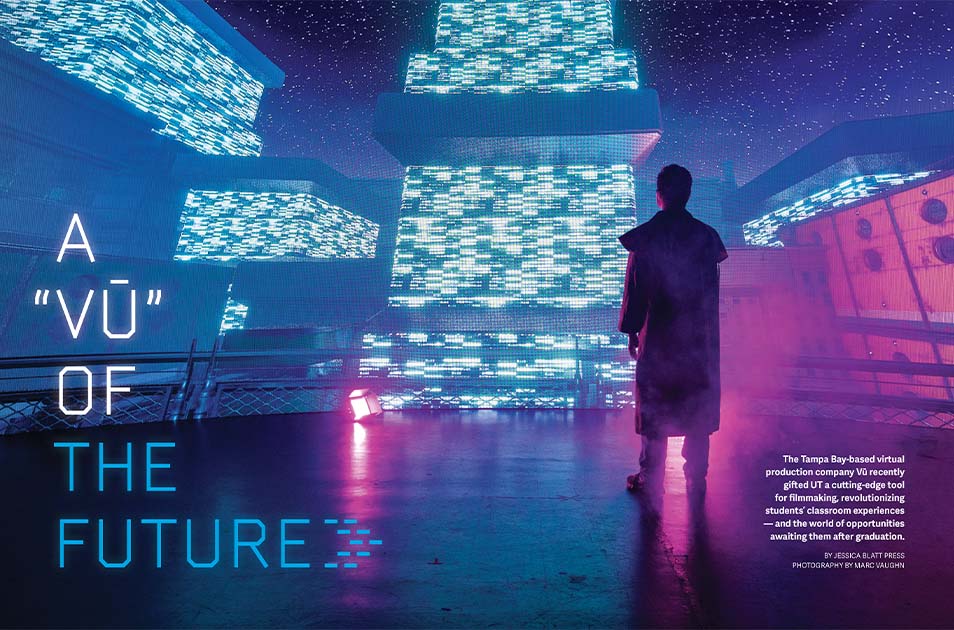
But thanks to a generous gift to UT’s Department of Film, Animation and New Media, students can now produce whatever their imaginations can dream up. Back in April, Vū, a local virtual production company, presented the department with an LED “volume” — a massive, curved screen that connects to a computer and can be used to create virtual backdrops. The technology (plus training at Vū) is valued at $750,000, but the world it opens up for students? That’s priceless.
That’s because these LED volumes are arguably the most cutting-edge technology in the film industry right now — and present the future of where the entertainment industry (not to mention fields like medicine, aerospace, the military and more) are headed. While they vary in size, the volume on campus is 13.1 feet tall by 29.5 feet wide and is made up of 72 interlocked panels. (For you tech geeks out there: That’s 2.4 million total pixels!)
“LED volumes are taking the world by storm, and for our students, it’s truly unlocked their creative potential,” says Gregg Perkins, associate professor of film, animation and new media. Perkins has been central to the relationship between Vū and UT, and he led the first-ever class involving the new technology — a weekly, four-hour, collaborative, workshop-style course called Virtual Production.
The overarching benefits of LED volumes are twofold: For one, they allow actors to be more fully immersed in a scene in which they’re acting (as opposed to having to act in front of a green or blue screen, which for decades has been the de facto way to create digital backdrops). For another, they allow filmmakers to create quite literally any setting they can imagine — without having to deal with the cost (and carbon footprint) of traveling to far-flung sets or waiting all day for the perfect sunset or lighting (or anything else that’s out of human control).
“You can move from the Sahara Desert in the morning to Iceland in the afternoon,” says Perkins. One of the most well-known current examples of the power of volume technology is The Mandalorian, the Emmy award-winning Disney+ TV series that is set in the “outer reaches of the galaxy.”
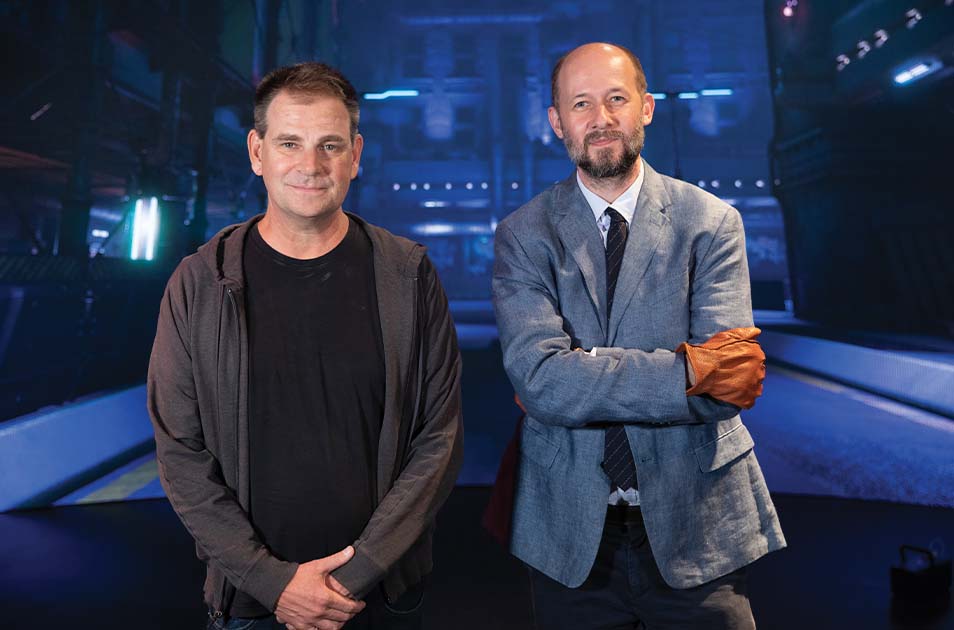 Gregg Perkins (left), associate professor of film, animation and new media, and Aaron Walker, associate professor and chair of the Department of Film, Animation and New Media
Gregg Perkins (left), associate professor of film, animation and new media, and Aaron Walker, associate professor and chair of the Department of Film, Animation and New Media
One person who certainly understands how special these screens is Hannah Sam ’23, from Lake Worth, FL, who participated in Perkins’ class last spring. She says the technology has “completely changed the game and how we view things here.” Last semester, she and her peers were able to create a series of films set in locales as diverse as a dungeon, a village, a jungle and a temple.
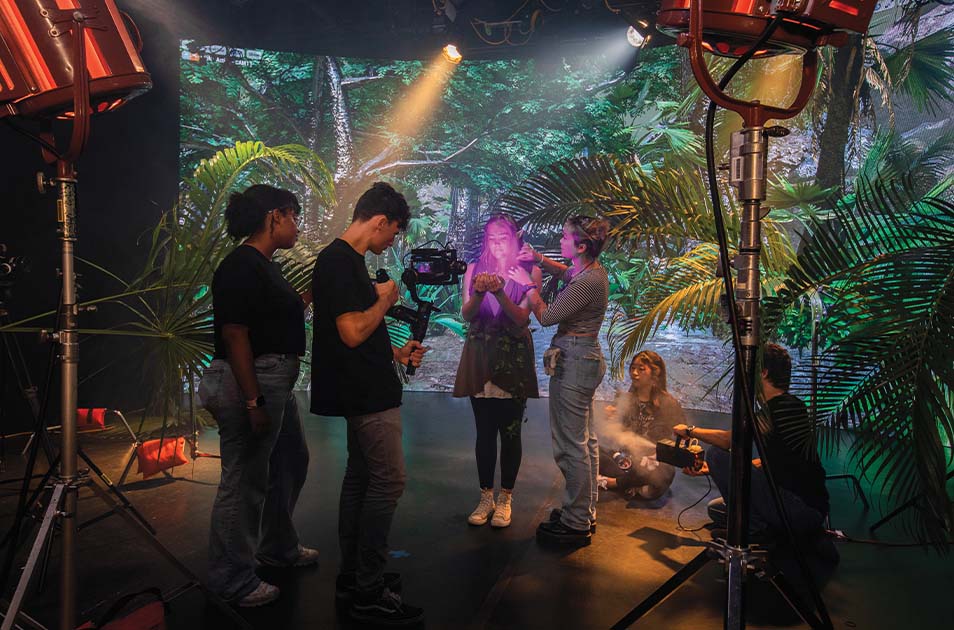 UT students film a jungle scene for an original short film called The Goddess’s Relic.
UT students film a jungle scene for an original short film called The Goddess’s Relic.
“As student filmmakers, a lot of the time if you want to create something, you’re limited by your financial status or what you can physically build. But now, we could write a whole medieval elf sequence if we wanted, because we have this incredible technology at our disposal,” she says.
As another student eloquently put it to Perkins during class: “Now, I can write a screenplay set on the moon!”
CREATING THE PIPELINE
Vū is actually an outgrowth of another company, Diamond View Studios, founded by Tim Moore 14 years ago as a video production company. For years, the company focused mainly on commercial work.
Then, the pandemic hit. No longer able to travel to their distant clients, Moore and his team went into problem-solving mode. “How do we get the location to travel to us?” they wondered. The answer was LED volumes, which they began selling under a sub-brand, Vū. Within a year, Vū had outperformed Diamond View Studios, and its growth has only continued to explode.
The company now has studios with volumes set up in Tampa, Orlando, Nashville and Las Vegas. And they have clients in cities from Naples, FL, all the way up to Toronto. “It’s been a very interesting evolution in that we didn’t expect it to be this successful, but it’s taken off like a rocket ship,” Moore says.
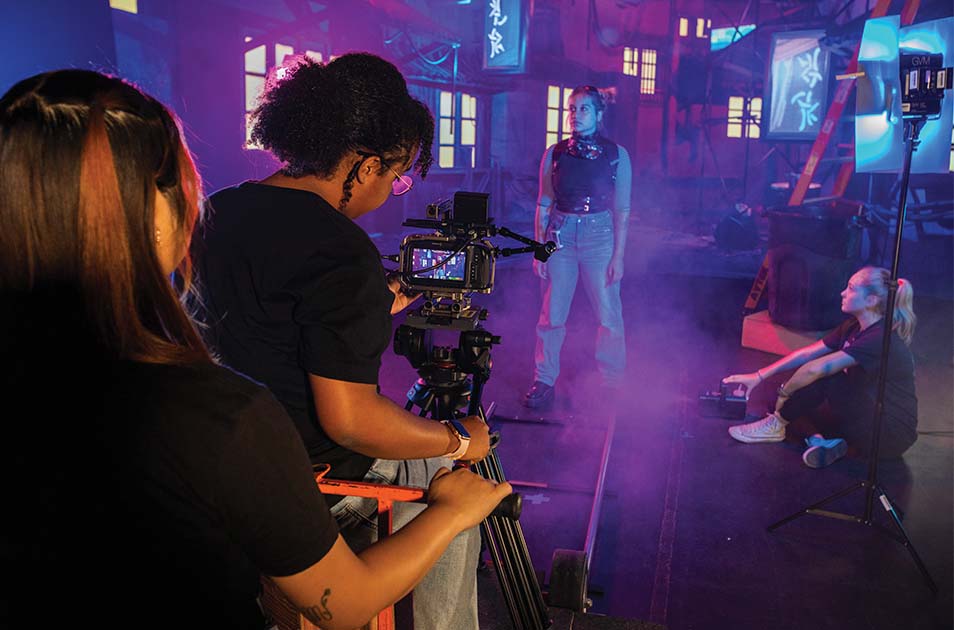 Hannah Sam ’23 films Aiyanah Esparza ’24 in a scene from an original short film called "The Oracle."
Hannah Sam ’23 films Aiyanah Esparza ’24 in a scene from an original short film called "The Oracle."
When Moore and his team built that first volume in 2020, it was only the fourth permanent one in the world — today, there are roughly 80-90 of them, of varying sizes.
But the key to unlocking the technology’s full potential? That comes down to training a workforce to operate it. “This is a vocational skill at heart. And any vocational skill is just a matter of how many times you can test and try to get better at it,” Moore says. “Having the technology on-site at UT is going to give students the ability to try this for years before they come into the industry, which will make them better and more well-rounded for a career in virtual production.” His ultimate goal: to make UT one of the largest providers of the virtual production workforce.
As Sam, the student in Perkins’ first cohort, explains it, using the technology is a multi-step process. “First, there’s our pre-production phase, the planning that happens even before we have our cameras out on production day. We’ll start writing and creating the world we want to build using a 3D computer graphics application called Unreal Engine. Once that’s set, we can begin getting together a crew and cast,” she says.
When shoot day arrives, she’ll make sure she has a final shot list, then project the scene onto the volume, and set up the lighting and props. “Doing our best to make sure that lighting and props seamlessly match the virtual world is what really ‘sells’ the look,” she says. Without using the actual talent yet, Sam will have people stand in actors’ designated places to see how it will ultimately look altogether.” That way, she says, she can make sure props and lighting are set without wasting talent time or putting anyone at risk while equipment is being adjusted.
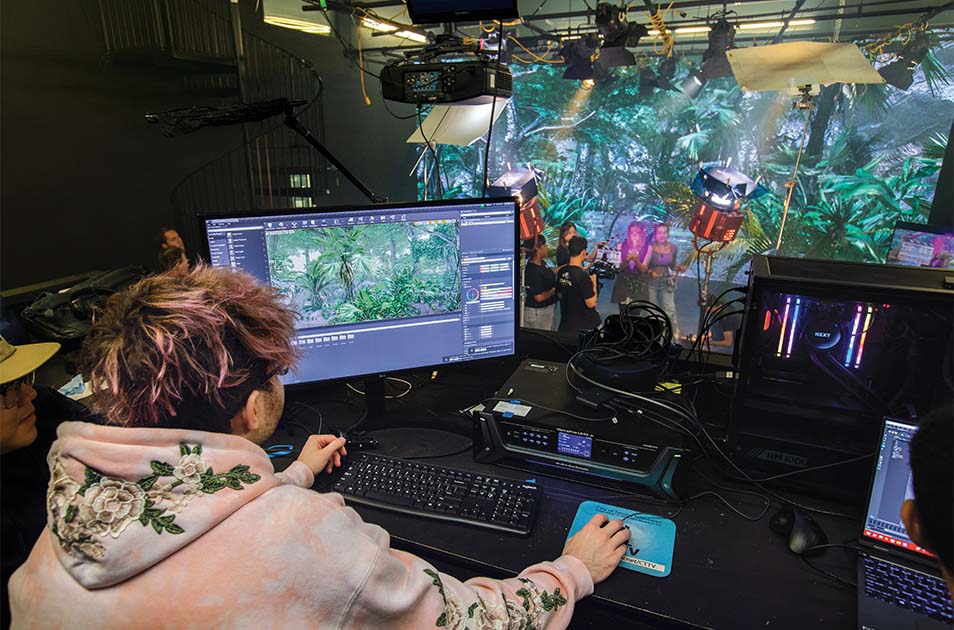 A student uses a 3D computer graphics application called Unreal Engine to create the scene on the screen.
A student uses a 3D computer graphics application called Unreal Engine to create the scene on the screen.
“After that, we can bring talent and cameras in and start seeing how it will look together.” She’s excited for UT’s “tracking” capabilities to evolve, which would allow the camera to move within the virtual world. And she says that she can already sense the competitive edge she and her classmates have. “The class was so hands-on and interactive,” she says, “that I know it will give me an advantage over other people applying for the same jobs when I graduate.”
And it’s not just film students at UT who will be able to broaden their skill set. The studio is also a place where students in the new M.A. in Social and Emerging Media will be able to flex their creative muscles in the future.
THE NEXT HOLLYWOOD?
Tyler Martinolich ’05, executive director at Film Tampa Bay, particularly admires the innovation behind the partnership between UT and Vū. “Any university’s main responsibility is preparing the next generation of the workforce, and that’s only doable if a university is willing to adapt and change with evolving technologies,” he says. “The way that UT and Vū are staying at the forefront of this tech, it’s enhancing not only the educational experience of students, but ensuring that when they graduate, they know and understand the tools of today and tomorrow.”
Tampa Bay, he explains, is already a popular commercial filming destination in the Southeast — but being one of the earliest adopters of this LED volume technology has set Tampa Bay apart. “It puts us on a totally different level as far as the types of projects we’re able to attract,” he says.
In the last few years alone, many A-list productions have come to Tampa Bay to shoot at Vū. WrestleMania, Mercedes Benz, Super Bowl promos and the Twenty One Pilots’ music video for the song “Shy Away” (see more on that on the sidebar on page 18), to name just a few, were all filmed locally.
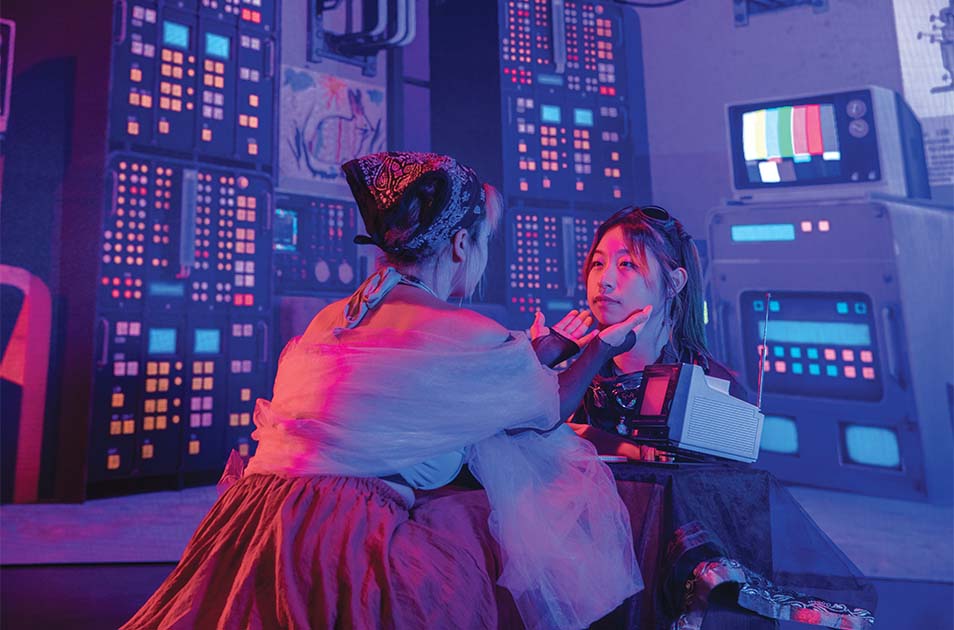 Two students film a scene from an original short film called "The Oracle."
Two students film a scene from an original short film called "The Oracle."
Aaron Walker, associate professor and chair of the Department of Film, Animation and New Media, is understandably proud of the Vū/UT partnership, and the potential it holds.
“COVID-19 accelerated the need for this kind of production, but our industry was always going in this direction,” Walker says. “Our students are in a one-of-a-kind training ground and exploratory lab right now,” Walker says.
Today, Tampa Bay — tomorrow, the moon?
FROM THE CLASSROOM TO THE EDITING ROOM
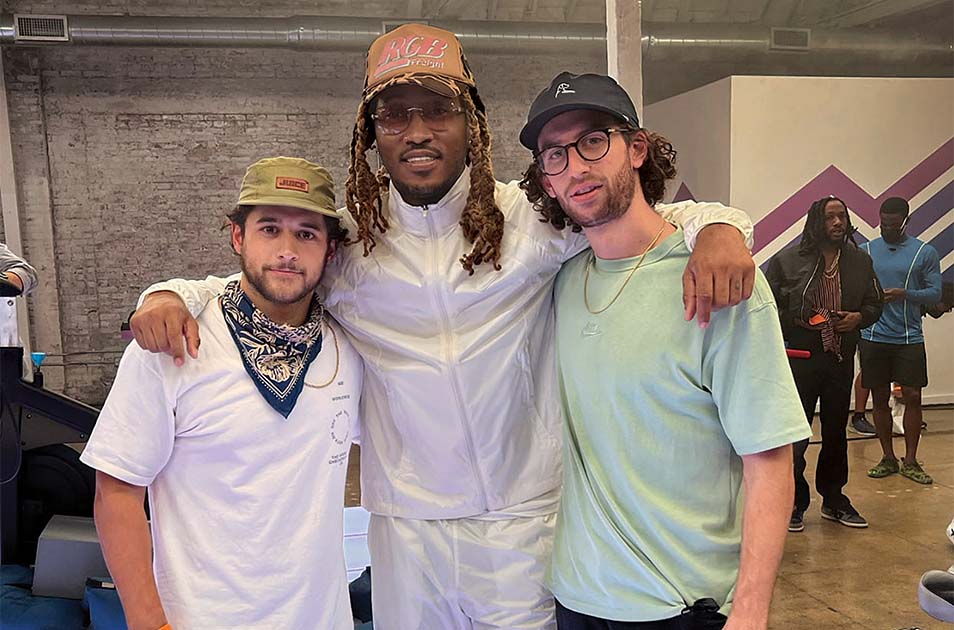 Left to right: AJ Favicchio ’13, the rapper Future and former UT student Miles Cable, who are generating buzz in the film world.
Left to right: AJ Favicchio ’13, the rapper Future and former UT student Miles Cable, who are generating buzz in the film world.
AJ Favicchio ’13 and former UT student Miles Cable are generating buzz in the film world for their expertise with tech like Vū’s LED volumes.
Growing up as the youngest of three boys in Cranston, RI, AJ Favicchio ’13 was always watching movies with his older siblings. “I was kind of at the mercy of what my brothers were watching: movies from the ’80s — and then there was Back to the Future, which just blew my mind. That was huge.”
Technology came a long way by the time Favicchio arrived at UT years later. Once on campus, he decided to pursue film and entrepreneurship — in the classroom and in the real world. “I started making commercials that were short-film-esque. They didn’t have any actors; they were just me, telling a story,” he says. When one of them (a video about his study abroad program in Rome) went viral, UT took notice and subsequently hired him to make a promotional video about the University’s burgeoning entrepreneurship program.
While at UT, Favicchio also interned at Diamond View Studios, and through that network, he met another former UT student, Miles Cable. A few years later, when the two moved to L.A. and decided to work together as a director duo, Miles & AJ, their ties to Tampa and Diamond View Studios remained strong: They recently filmed the music video for the Twenty One Pilots’ song “Shy Away” using an LED volume at Diamond View Studios’ Tampa location. Their client list also includes A-list brands like Samsung, Vans and Oakley, as well as mega-musicians like Billie Eilish and Doja Cat. They’re also working on a campaign for a video game company that will involve a volume.
Favicchio and Cable have seen firsthand how having specialized skills have set them apart and increased their client portfolio. So, naturally, Favicchio thinks Vū’s gift to UT is a game-changer. As he says: “What Vū has done, and how they’ve made it readily available to students — that’s profound.”
